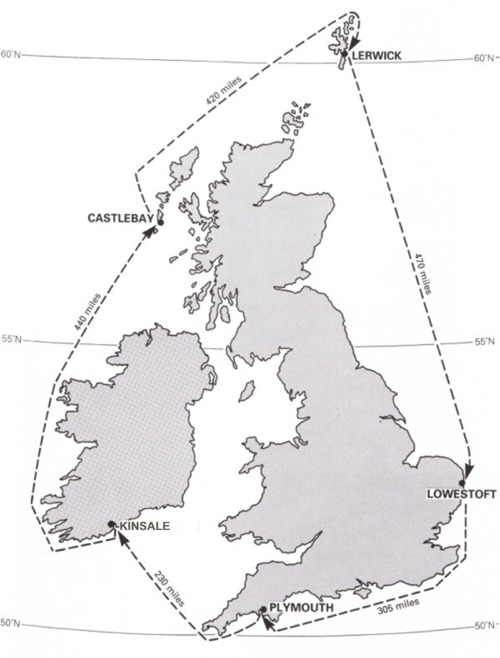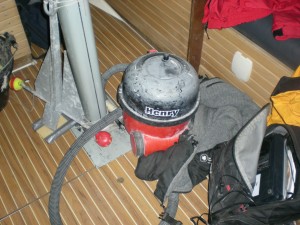The boat and job lists

My ‘little’ brother Myles (he is 23 and 6 foot 3!) and I spent a crazy 3 weeks before this race rebuilding Dad’s boat. I got back from Antarctica and the massive job list which was meant to be done over the winter on the boat had not been touched much to my disappointment and dismay. We had run a foul of the STIX number on the boat not being high enough to qualify for the race. However come hell or high water the little Santana was going to race – as far as my family was concerned we knew she was perfect for it. We took 30 kg of lead and bolted it to the keel stepped the mast and put in the rudder and the measured interior. That all sounds easy but the boat was full of fiberglass dust as all the bulkhead tabbing had been done badly by the yard had to be ground out. At a quiet marina in the River Hamble we had a ORC measurer do an incline test on her which involved a couple of 2 by 4’s some jerry cans full of water, lots of measuring and spirit levels! On tender hooks all weekend we awaited the numbers from the ORC office and low and behold we had a boat that was stable enough to do the race. Mast came back down, rudder came back out, interior stripped again and work commenced at full tilt with many of Myles’s friends coming down and putting in a few hours here and there doing what they could on the boat. Meanwhile Myles wrote 1000’s of words for his Masters and I had to go back to San Francisco to see my clients I had neglected for 8 months. The job list seemed more extensive than Ocean Planets during the Around Alone!
The boat is a Capo 30 my father bought in 2000 in Detroit and shipped it to the UK. Carl Schumacher who designed the boat was a family friend and before the Capo we had an Express 27 in the UK. Built at Westerly in 1984 she has become a bit of an anomaly with an Alan Andrews keel (now extended), a Merf Owen rudder, and some structural engineering done by the South African America’s Cup team allowing us to open up some bulkheads down below for easier access into the aft bunks. We are the smallest boat in the race little Santana is doing her original designer and everyone since proud.
If you had seen Santana a week before the race you would think there was no way she was going to be at the start especially as we still had a 300 mile qualifier to do. Indeed Pip who is winning the race overall (in another Carl Schumacher boat) commented to her friends that she didn’t think we would make it. She didn’t know then like she does now about how the Perrin family operates.

My boyfriend Clive was dragged over from Northern Ireland and spent 6 sixteen hour days with power tools, my mother wandered around the boat with a Henry the vacumn cleaner trying to get rid of fiberglass dust and kept the troops happy with food and drinks. My father ran around picking up parts and pieces around Hampshire and further. A sample of what we did during those 2 weeks to comply with Cat 2 regs and for the boat to be structurally capable ….
– Installed Hydra 3000 instruments (we have only ever had depth and log) including a whole new wiring harness in the rig
– Rewired the entire boat
– Installed VHF, GPS with DSC, AIS Class B, stereo with speakers, computer with navigation software
– Cut out over 2 feet of rotten balsa core around the mast partners and rebuilt the area and more core around stanchion bases
– New lifelines and stanchions which we also moved out to the side and backed with G10 plates (everything had to be epoxy plugged)
– Completely retabbed the entire boat and scarfed in new marine ply where the chainplate bulkheads had rottened out including building foam knees for additional support and glassing that in
– Rebuilt the companionway hatch so the liferaft could be stowed up top
– Replumbed the stove so the shut off valve could be accessed without leaning over the flame!
– Put latches on the engine cover and hatches, tied down the batteries
– Installed my Dad’s tiller pilot from the 80’s which is useless and has already died
– Melted down the lead to shape for the keel extension bolted it on and faired it in
– Wet sanded the bottom and repainted the keel and rudder with orange antifoul
– Rebuilt the winches, serviced the engine, sent the sails off for some repairs
– Installed a new rod rigging backstay, forestay and tuff luff
– Painted our sail numbers on deck and on the side of the boat
So everything needed doing from the top of the rig to the bottom of the keel to be ready for what I consider one of the seven summits of offshore sailing the list went on and on. While Myles and I did the qualifier my mother cooked up a storm in the kitchen making us homemade meals and treats which we could reheat in the pressure cooker and Dad booked all the ferries to act as a support team.

